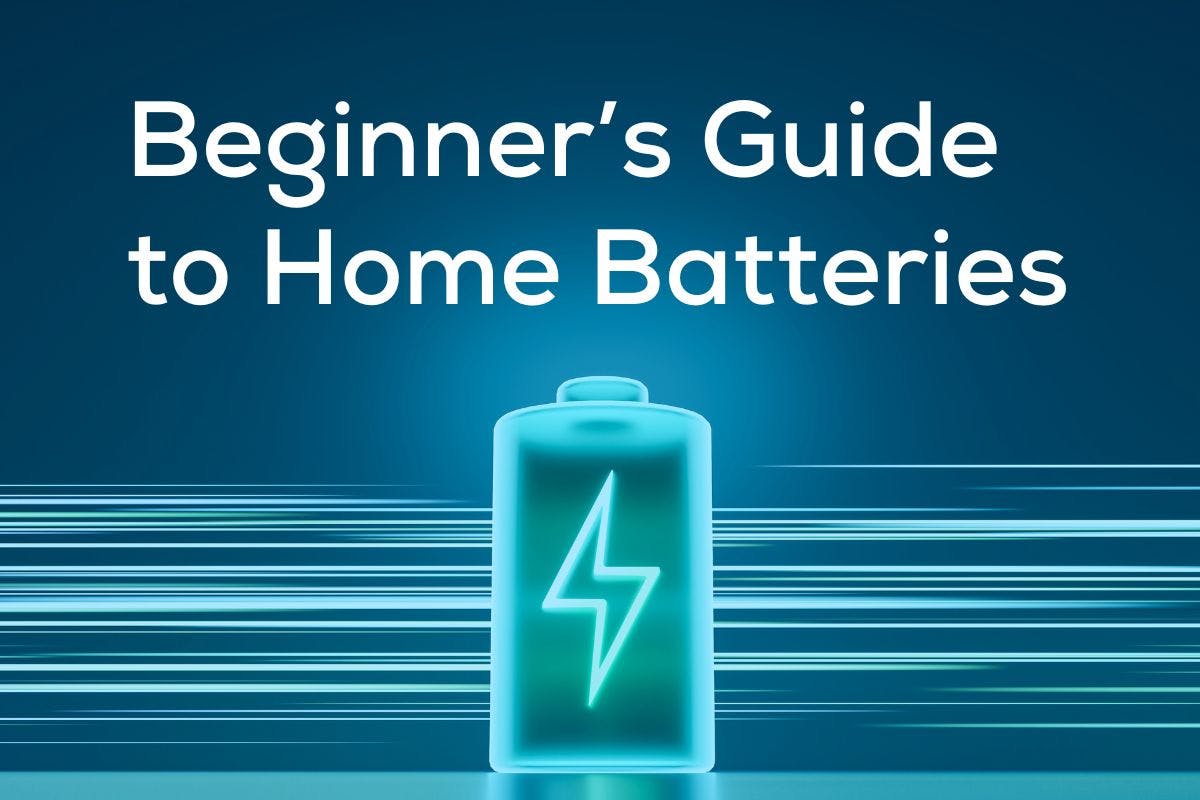The Beginner’s Guide to Home Battery Storage Systems
Last edited

Author
Andrew Blok
Electrification and Solar Writer and Editor

Editor
Andrew Giermak
Solar and Electrification Writer and Editor

Home solar panels are providing clean energy to more homeowners than ever before and lowering energy bills in the process. More and more people who go solar are also installing a battery, which can provide some backup power during an outage and, in some cases, boost your solar savings.
If you’re looking to add a battery to your home (with or without solar panels) here’s what you need to know about how a home battery works, what it can do, and whether it’s a good fit for your home.
See how much you can save by going solar with Palmetto
Understanding Home Battery Storage Systems
Home battery storage systems are large, stationary batteries that store energy for later use or during a blackout. While the Tesla Powerwall is the most widely known and installed home battery, the playing field is getting more crowded.
Home batteries can charge using grid power or solar power to use when the sun or the grid goes down.
Today’s batteries often come with energy management algorithms that let you set different priorities for your battery and solar system. Whether you want to use and store as much solar power as possible before sending it back to the grid, avoid buying electricity at the most expensive times, or just keep your battery charged up in case of a blackout, modern batteries can do that.
Battery systems require a few additional components, like an inverter (which converts the battery’s direct current electricity to the alternating current your house and the grid uses), mounting hardware, and additional wiring. Most battery manufacturers also have an app for managing your battery’s charge level and settings.
Batteries configured to back up your home in case of a power outage will have additional equipment and wiring that lets the battery isolate your home from the grid and send power to select circuits. Batteries without backup capabilities require less hardware and labor, making them less expensive projects overall.
The most common type of battery uses lithium-ion chemistry, like bigger versions of the batteries that power your phone or laptop. As battery technology matures, more flavors of the lithium-ion battery are popping up and entirely new battery chemistries could be on the horizon. Lithium iron phosphate batteries are a newer chemistry that is a bit safer, longer lasting, and better at high and low temperatures than some earlier lithium-ion batteries. That makes it an increasingly popular choice for home storage. Older lead acid batteries are less common in home energy storage but sometimes play a role.
Why Consider a Home Battery Storage System?
Home batteries have plenty of benefits which vary with how you use them.
Energy independence
Batteries can protect you from blackouts, which have been increasing in frequency thanks to more severe weather and aging transmission infrastructure. On their own, batteries can keep your home’s essentials powered up during an outage, though without a way to charge, a battery may not get you through an extended outage.
Paired with solar panels, which can charge a battery throughout the day, home battery storage systems can keep your essentials running through an extended outage. The appliances you want to power with your batteries will determine how many you need. How much power those appliances require to both start and run are important considerations.
Batteries are essentially a requirement to keep solar panels running during a blackout. Without a backup battery, solar panels are designed to shut down with the grid for safety reasons.
Cost savings
Solar panels are financially beneficial in two ways: They let you avoid buying energy from your utility and, where programs are available, they let you sell energy back to it at the most valuable time.
Without a battery, solar panels let you avoid buying grid energy when the sun is out. Storing extra energy for later use can let you avoid even more.
Many utilities compensate you for the electricity your solar panels send back to the grid, though at different rates throughout the day. Storing that energy to sell back to the grid at the most valuable time is another way to boost the value of your solar panels. This is how it works for many Californians, thanks to NEM 3.0. In many other parts of the country, batteries may not save money, so their value comes from their backup ability.
Increased solar utilization
Just like you can store electricity and use it to maximize your savings, you can do it to maximize the amount of clean solar energy you use. By storing extra solar power and using it later, you can maximize your savings and your environmental impact.
Choosing the Right Home Battery Storage System
Choosing the right home battery requires matching it to your energy goals. Here’s what sets batteries apart.
Capacity: Capacity, measured in kilowatt-hours, is how much actual electricity a battery stores. A Tesla Powerwall has a 13.5 kWh capacity. A Generac PWRcell has a starting capacity of 9 kWhs that can increase in increments of 3 kWhs up to 18 kWhs.
Power rating: Power output is typically given in two numbers: continuous and peak. Continuous output is how much power the battery can release at a continuous rate. Peak output is how much a battery can release over a shorter time, typically a few seconds. Since many appliances require a brief burst of energy to start up, peak output is an important factor.
Warranty and lifespan: Like any battery, home batteries degrade with time and use. Warranties are typically measured in years and charge-discharge cycles. If a warranty guarantees 70% capacity for 10 years and 7,000 cycles, you should have at least 70% of the battery’s original capacity at least until reaching either of those benchmarks.
Efficiency: No battery system is 100% efficient. A battery with a 90% efficiency will give you 9 kWhs of electricity for every 10 kWhs you put in.
To get an idea of how much energy capacity and power output you need, first decide what you’ll need in an emergency. The fewer appliances you back up, the less battery capacity and power required. A professional battery installer will be able to advise you, but you can get an idea by looking at the appliances you want to back up.
You can find your appliances’ energy requirements on a sticker attached to the appliance itself or in the owner’s manual. In my apartment, my refrigerator draws 517.5 watts, my microwave draws 1500 watts, and my water heater draws 4,500 watts. If all of those were running continuously for an hour they’d consume about 6500 watt-hours, or 6.5 kWhs, about half a Powerwall’s capacity. None of these appliances run continuously, though.
Another way to think about your battery capacity needs is through your average consumption. In 2022, the average American household bought about 900 kWhs of electricity each month, or about 30 kWhs each day, though you’ll likely use less when trying to conserve energy during a blackout.
Here’s the base capacity of leading home batteries today.
- Tesla Powerwall 3: 13.5 kWh
- Generac PWRcell: 9-18 kWh
- sonnenCore: 10 kWh
- LG 10H Prime: 10 kWh
- Enphase IQ10: 10.5 kWh
Installation and Maintenance
The vast majority of people should hire a professional to install their batteries. The installation process may vary by installer but generally follows a few typical steps.
- Site assessment: A battery installation professional comes and surveys your home for the best place to install the battery.
- Energy audit: If your battery is being installed with solar, the installer will want to get an idea of your energy consumption to correctly size your systems.
- Permitting: A standalone battery may need permits to be installed and permission from the utility to feed energy back to the grid, just like a solar system.
- Inverter installation: Your battery may need an additional inverter to convert the DC electricity it stores into the AC electricity your house uses.
- Mounting: The battery will be installed, usually on a wall or the floor.
- Connection: Your battery will be connected to your house’s electrical system and tested to make sure it’s working.
- Monitoring: Monitor your battery’s charge and performance through the manufacturer's app.
See how much you can save by going solar with Palmetto
Lithium-ion batteries are low-maintenance technology. Aside from making sure you don’t drain them too low — which may be automated — as long as you don’t physically harm them, you shouldn’t have any problems.
Your battery will degrade, though that’s not something to worry about. Most batteries have a certain level of degradation covered in their warranty. If you believe your battery is performing below that level, contact the manufacturer.
A very small number of batteries have caught fire from a process known as thermal runaway. It’s not common but is more likely with damaged, poorly manufactured, or poorly installed batteries. If your battery is damaged after installation, get it inspected by a professional.
Home Battery Storage Systems Costs
A home battery installation can cost more than $10,000, but it can enhance your solar savings and provide non-monetary benefits like keeping important systems powered up during an unexpected blackout.
Government incentives, like the 30% clean energy tax credit, can lop thousands of dollars off of that cost. Utilities may also have battery incentives. Xcel Energy offers rebates for batteries if you participate in occasional ‘control events,’ where the utility takes some of your battery’s stored energy to meet peak demand. Other utilities or third-party companies offer similar incentives.
Of the people who install home batteries, over 50% do so primarily for backup power, according to a survey of installers by SolarReviews. But even when the goal is resilience, batteries can earn some money back by joining a virtual power plant to send power to the grid when it’s needed.
Paired with solar, a home battery storage system can save you money in places where avoiding grid electricity is more valuable than sending solar power back to your utility. The percentage of solar installations with batteries attached jumped from 10% to 60% after California utilities changed from a net metering system to a net billing one, according to the Lawrence Berkeley National Laboratory.
Future Trends in Battery Storage
Even though modern battery technology is sophisticated and capable, more innovation is on the way.
As big batteries become more common at homes and in cars, they’ll likely get cheaper. That would continue the trend of the last decade, according to BloombergNEF, which says battery packs cost $139/kWh in 2023, down from $780/kWh in 2013. BloombergNEF predicts prices as low as $80/kWh in 2030. (This price isn’t for the finished product and includes batteries used in vehicles and stationary storage, like at home. It’s not representative of the price you’ll pay an installer, but does illustrate a real trend in price.)
Batteries will also likely get smarter. Many batteries can already work with complicated utility rates to help you avoid buying the most expensive electricity. As homes get more internet-connected devices, batteries will have more potential to be more specific and nimble in how they power your house. Technology like smart electric panels and breakers will increase their flexibility.
Batteries also stand to play a large role in the energy transition as more wind and solar power are added to the grid. Since the sun doesn’t always shine and the wind doesn’t always blow, storing energy for later use will be necessary. Expect virtual power plants and other compensation schemes for residential batteries to continue and expand.
Does a Home Battery Make Sense for You?
Home battery storage systems offer resilience and additional energy savings, especially when paired with solar. They can help you weather a blackout, avoid expensive grid electricity, and let you use power from your solar panels, even after the sun goes down. Depending on where you live, your savings could be even greater with additional storage incentives or the option to join a virtual power plant.
To find out how solar and storage can reduce your monthly electric bill, start with Palmetto’s solar savings Cclculator and reach out to one of our solar advisors today for a personalized solar quote.
See what solar can do for you:
Frequently Asked Questions
Are solar home battery storage systems worth it?
Batteries can save you more money than standalone solar in some parts of California. In other places, they may not pay for themselves in savings, but can provide valuable emergency backup power that’s cleaner and quieter than a generator.
Can a battery back up my house?
Backup batteries can provide emergency electricity during an outage. Often, they backup specific circuits in your home that power essential appliances or devices. You may have the option to set your battery up as an arbitrage, or consumption only, battery. These battery configurations don’t offer backup power.
Disclaimer: This content is for educational purposes only. Palmetto does not provide tax, legal, or accounting advice. Please consult your own tax, legal, and accounting advisors.


